IN ADULTS WITH MODERATE TO SEVERE PLAQUE PSORIASIS
STELARA® Safety Profile
ADVERSE EVENTS, SERIOUS ADVERSE EVENTS, INFECTIONS, SERIOUS INFECTIONS AND MALIGNANCIES PER 100 PATIENT-YEARS THROUGH YEAR 5 IN STELARA® GLOBAL STUDIES 1*†
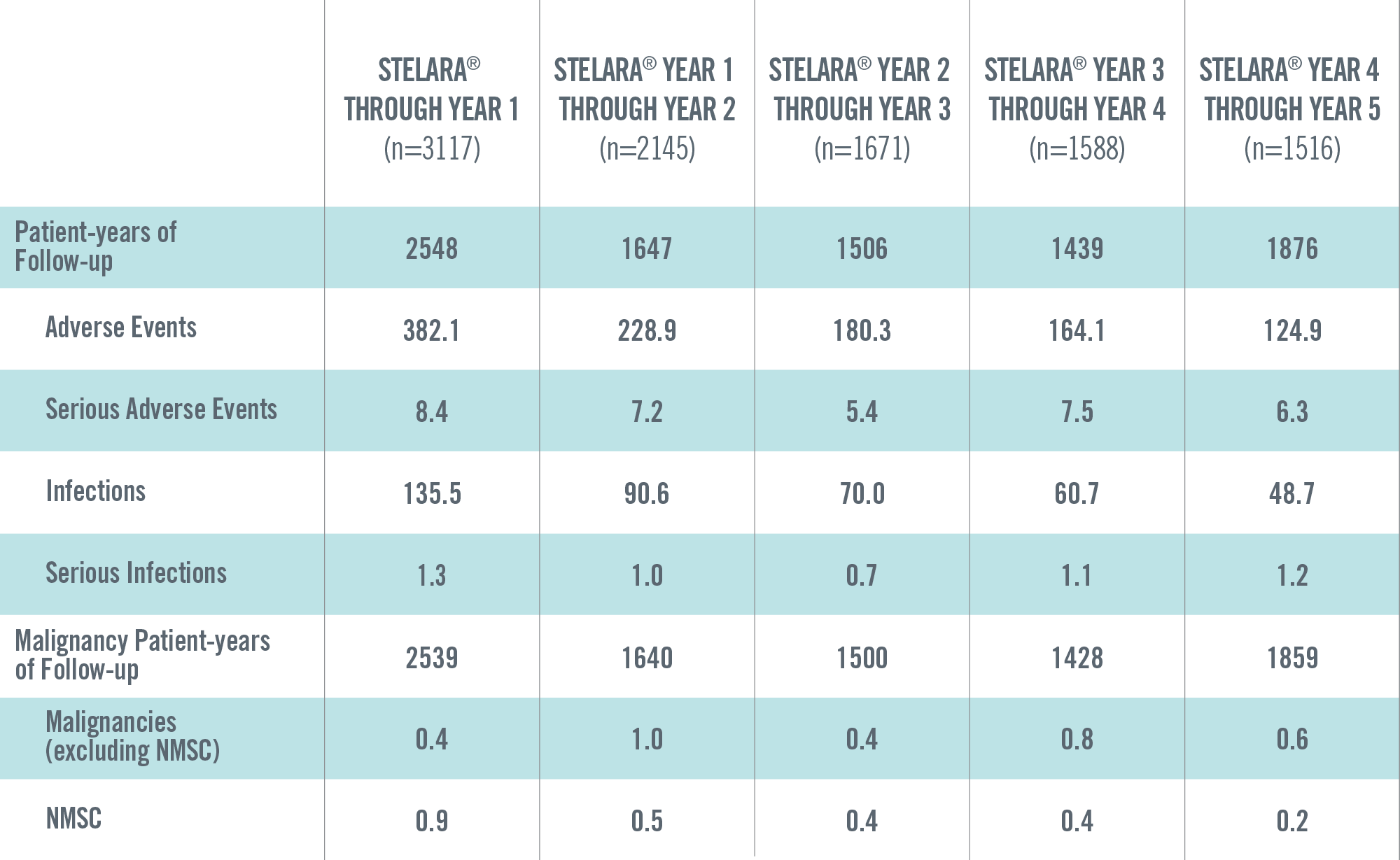
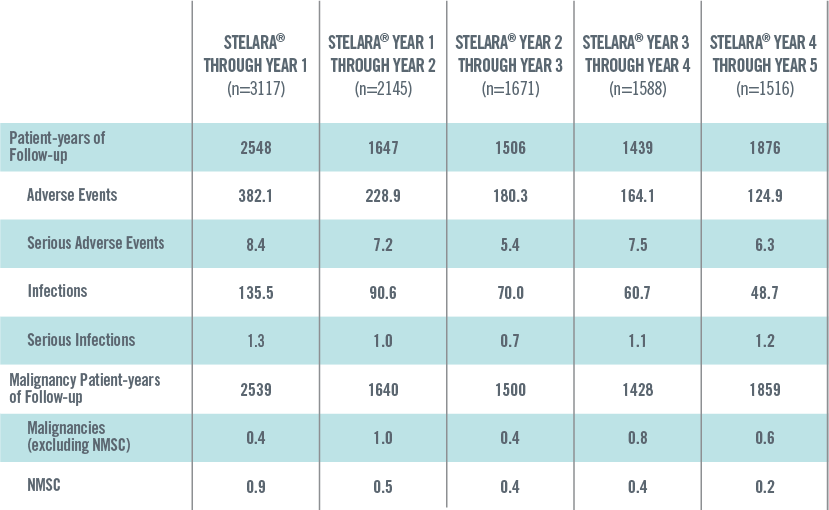
*Includes Phase 2 (NCT00320216) and Phase 3 (PHOENIX 1, PHOENIX 2, ACCEPT) studies. These studies have varied exposure: in general, Year 1 reflects the data from all 4 studies, and Years 2 through 5 reflect the data primarily from PHOENIX 1 and PHOENIX 2.
†Year 1 is defined as ≤Week 48; Year 2 is defined as >Week 48 to ≤Week 96; Year 3 is defined as >Week 96 to ≤Week 144; Year 4 is defined as >Week 144 to ≤Week 192; Year 5 is defined as >Week 192.
Adverse Reactions Reported by ≥1% of Adult Patients Through Week 12 in PHOENIX 1 and PHOENIX 22
The safety data reflect exposure to STELARA® in 3117 adult psoriasis subjects, including 2414 exposed for at least 6 months, 1855 exposed for at least 1 year, 1653 exposed for at least 2 years, 1569 exposed for at least 3 years, 1482 exposed for at least 4 years and 838 exposed for at least 5 years.2
Events per 100 patient-years
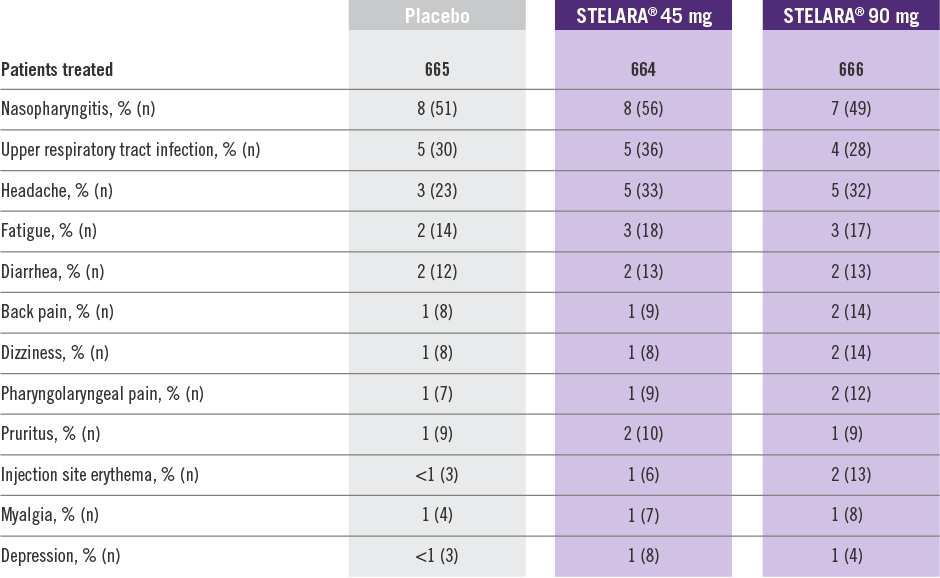
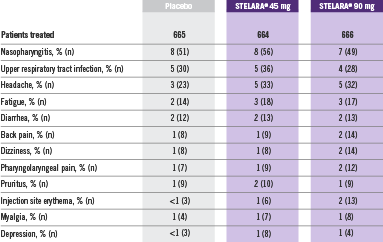
Adverse reactions that occurred in less than 1% in the controlled period of PHOENIX 1 and PHOENIX 2 through Week 12 included: cellulitis, herpes zoster, diverticulitis, and certain injection site reactions (pain, swelling, pruritus, induration, hemorrhage, bruising, and irritation).
One Case of Posterior Reversible Encephalopathy Syndrome (PRES) occurred during adult plaque psoriasis clinical studies.
In the placebo-controlled period of clinical studies of patients with psoriasis (average follow-up of 12.6 weeks for placebo-treated patients and 13.4 weeks for STELARA ®-treated patients)2:
27% of STELARA®-treated patients reported infections (1.39 per patient-year of follow-up) compared with 24% of placebo-treated patients (1.21 per patient-year of follow-up)
Serious infections occurred in 0.3% of STELARA®-treated patients (0.01 per patient-year of follow-up) and in 0.4% of placebo-treated patients (0.02 per patient-year of follow-up)
In the controlled and noncontrolled portions of psoriasis clinical trials (median follow-up of 3.2 years, representing 8998 patient-years of exposure)2:
72.3% of STELARA®-treated patients reported infections (0.87 per patient-year of follow-up)*
Serious infections were reported in 2.8% of patients (0.01 per patient-year of follow-up)
1.7% of STELARA®-treated patients reported malignancies excluding nonmelanoma skin cancers (NMSC) (0.60 per hundred patient-years of follow-up)
NMSC was reported in 1.5% of STELARA®-treated patients (0.52 per hundred patient-years of follow-up)
The most frequently observed malignancies other than NMSC during the clinical trials were prostate, melanoma, colorectal, and breast
Malignancies other than NMSC in STELARA®-treated patients during the controlled and noncontrolled portions of studies were similar in type and number to what would be expected in the general US population according to the Surveillance, Epidemiology, and End Results (SEER) database (adjusted for age, gender, and race). 2,3 †
Cumulative overall safety was evaluated during the placebo-controlled period (12 or 20 weeks) and up to 5 years of treatment.3
*Based on any adverse event, regardless of body system, which in the opinion of the investigator would be considered an infection.
†SEER database (2009), adjusted for age, gender, and race, compared with STELARA ® through the 2011 analysis.3
References: 1. Data on file. Janssen Biotech, Inc. 2. STELARA ® (ustekinumab) [package insert]. Horsham, PA: Janssen Biotech, Inc. 3. Papp KA, Griffiths CEM, Gordon K, et al; on behalf of the PHOENIX 1, PHOENIX 2, and ACCEPT Investigators. Long-term safety of ustekinumab in patients with moderate-to-severe psoriasis: final results from 5 years of follow-up. Br J Dermatol 2013;168(4):844-854.
INDICATIONS
STELARA® (ustekinumab) is indicated for the treatment of patients 6 years and older with active psoriatic arthritis.
STELARA® (ustekinumab) is indicated for the treatment of patients 6 years or older with moderate to severe plaque psoriasis who are candidates for phototherapy or systemic therapy.
STELARA® (ustekinumab) is indicated for the treatment of adult patients with moderately to severely active Crohn's disease.
STELARA® (ustekinumab) is indicated for the treatment of adult patients with moderately to severely active ulcerative colitis.
IMPORTANT SAFETY INFORMATION
STELARA® (ustekinumab) is contraindicated in patients with clinically significant hypersensitivity to ustekinumab or to any of the excipients.
Infections
Treatment with STELARA® should not be initiated in patients with a clinically important active infection until the infection resolves or is adequately treated. Consider the risks and benefits of treatment prior to initiating use of STELARA® in patients with a chronic infection or a history of recurrent infection. Instruct patients to seek medical advice if signs or symptoms suggestive of an infection occur while on treatment with STELARA® and discontinue STELARA® for serious or clinically significant infections until the infection resolves or is adequately treated.
Theoretical Risk for Vulnerability to Particular Infections
Individuals genetically deficient in IL-12/IL-23 are particularly vulnerable to disseminated infections from mycobacteria, Salmonella, and Bacillus Calmette-Guerin (BCG) vaccinations. Serious infections and fatal outcomes have been reported in such patients. It is not known whether patients with pharmacologic blockade of IL-12/IL-23 from treatment with STELARA® may be susceptible to these types of infections. Consider diagnostic testing, eg, tissue culture, stool culture, as dictated by clinical circumstances.
Pre-Treatment Evaluation of Tuberculosis (TB)
Evaluate patients for TB prior to initiating treatment with STELARA®. Do not administer STELARA® to patients with active tuberculosis infection. Initiate treatment of latent TB before administering STELARA®. Closely monitor patients receiving STELARA® for signs and symptoms of active TB during and after treatment.
Malignancies
STELARA® is an immunosuppressant and may increase the risk of malignancy. Malignancies were reported among patients who received STELARA® in clinical trials. The safety of STELARA® has not been evaluated in patients who have a history of malignancy or who have a known malignancy. There have been reports of the rapid appearance of multiple cutaneous squamous cell carcinomas in patients receiving STELARA® who had risk factors for developing non-melanoma skin cancer (NMSC). All patients receiving STELARA®, especially those >60 years or those with a history of PUVA or prolonged immunosuppressant treatment, should be monitored for the appearance of NMSC.
Hypersensitivity Reactions
Hypersensitivity reactions, including anaphylaxis and angioedema, have been reported with STELARA®. If an anaphylactic or other clinically significant hypersensitivity reaction occurs, institute appropriate therapy and discontinue STELARA®.
Posterior Reversible Encephalopathy Syndrome (PRES)
Two cases of posterior reversible encephalopathy syndrome (PRES), also known as Reversible Posterior Leukoencephalopathy Syndrome (RPLS), were reported in clinical trials. Cases have also been reported in postmarketing experience in patients with psoriasis, psoriatic arthritis and Crohn’s disease. Clinical presentation included headaches, seizures, confusion, visual disturbances, and imaging changes consistent with PRES a few days to several months after ustekinumab initiation. A few cases reported latency of a year or longer. Patients recovered with supportive care following withdrawal of ustekinumab.
Monitor all patients treated with STELARA® for signs and symptoms of PRES. If PRES is suspected, promptly administer appropriate treatment and discontinue STELARA®.
Immunizations
Prior to initiating therapy with STELARA®, patients should receive all age-appropriate immunizations as recommended by current immunization guidelines. Patients being treated with STELARA® should avoid receiving live vaccines. Avoid administering BCG vaccines during treatment with STELARA® or for one year prior to initiating treatment or one year following discontinuation of treatment. Caution is advised when administering live vaccines to household contacts of patients receiving STELARA® because of the potential risk for shedding from the household contact and transmission to patient. Non-live vaccinations received during a course of STELARA® may not elicit an immune response sufficient to prevent disease.
Noninfectious Pneumonia
Cases of interstitial pneumonia, eosinophilic pneumonia, and cryptogenic organizing pneumonia have been reported during post-approval use of STELARA®. Clinical presentations included cough, dyspnea, and interstitial infiltrates following one to three doses. Serious outcomes have included respiratory failure and prolonged hospitalization. Patients improved with discontinuation of therapy and, in certain cases, administration of corticosteroids. If diagnosis is confirmed, discontinue STELARA® and institute appropriate treatment.
Allergen Immunotherapy
STELARA® may decrease the protective effect of allergen immunotherapy (decrease tolerance) which may increase the risk of an allergic reaction to a dose of allergen immunotherapy. Therefore, caution should be exercised in patients receiving or who have received allergen immunotherapy, particularly for anaphylaxis.
Most Common Adverse Reactions
The most common adverse reactions (≥3% and higher than that with placebo) in adults from plaque psoriasis clinical trials for STELARA® 45 mg, STELARA® 90 mg, or placebo were: nasopharyngitis (8%, 7%, 8%), upper respiratory tract infection (5%, 4%, 5%), headache (5%, 5%, 3%), and fatigue (3%, 3%, 2%), respectively. The safety profile in pediatric patients with plaque psoriasis was similar to that of adults with plaque psoriasis. In psoriatic arthritis (PsA) trials, a higher incidence of arthralgia and nausea was observed in patients treated with STELARA® when compared with placebo (3% vs 1% for both). In Crohn’s disease induction trials, common adverse reactions (3% or more of patients treated with STELARA® and higher than placebo) reported through Week 8 for STELARA® 6 mg/kg intravenous single infusion or placebo included: vomiting (4% vs 3%). In the Crohn’s disease maintenance trial, common adverse reactions (3% or more of patients treated with STELARA® and higher than placebo) reported through Week 44 for STELARA® 90 mg subcutaneous injection or placebo were: nasopharyngitis (11% vs 8%), injection site erythema (5% vs 0%), vulvovaginal candidiasis/mycotic infection (5% vs 1%), bronchitis (5% vs 3%), pruritus (4% vs 2%), urinary tract infection (4% vs 2%) and sinusitis (3% vs 2%). In the ulcerative colitis induction trial, common adverse reactions (3% or more of patients treated with STELARA® and higher than placebo) reported through Week 8 for STELARA® 6 mg/kg intravenous single infusion or placebo included: nasopharyngitis (7% vs 4%). In the ulcerative colitis maintenance trial, common adverse reactions (3% or more of patients treated with STELARA® and higher than placebo) reported through Week 44 for STELARA® 90 mg subcutaneous injection or placebo included: nasopharyngitis (24% vs 20%), headache (10% vs 4%), abdominal pain (7% vs 3%), influenza (6% vs 5%), fever (5% vs 4%), diarrhea (4% vs 1%), sinusitis (4% vs 1%), fatigue (4% vs 2%), and nausea (3% vs 2%).
Please see full Prescribing Information and Medication Guide for STELARA® . Provide the Medication Guide to your patients and encourage discussion.
cp-124933v7
INDICATIONS
STELARA® (ustekinumab) is indicated for the treatment of patients 6 years and older with active psoriatic arthritis.
STELARA® (ustekinumab) is indicated for the treatment of patients 6 years or older with moderate to severe plaque psoriasis who are candidates for phototherapy or systemic therapy.
STELARA® (ustekinumab) is indicated for the treatment of adult patients with moderately to severely active Crohn's disease.
STELARA® (ustekinumab) is indicated for the treatment of adult patients with moderately to severely active ulcerative colitis.
IMPORTANT SAFETY INFORMATION
STELARA® (ustekinumab) is contraindicated in patients with clinically significant hypersensitivity to ustekinumab or to any of the excipients.
Infections
Treatment with STELARA® should not be initiated in patients with a clinically important active infection until the infection resolves or is adequately treated. Consider the risks and benefits of treatment prior to initiating use of STELARA® in patients with a chronic infection or a history of recurrent infection. Instruct patients to seek medical advice if signs or symptoms suggestive of an infection occur while on treatment with STELARA® and discontinue STELARA® for serious or clinically significant infections until the infection resolves or is adequately treated.
Theoretical Risk for Vulnerability to Particular Infections
Individuals genetically deficient in IL-12/IL-23 are particularly vulnerable to disseminated infections from mycobacteria, Salmonella, and Bacillus Calmette-Guerin (BCG) vaccinations. Serious infections and fatal outcomes have been reported in such patients. It is not known whether patients with pharmacologic blockade of IL-12/IL-23 from treatment with STELARA® may be susceptible to these types of infections. Consider diagnostic testing, eg, tissue culture, stool culture, as dictated by clinical circumstances.
Pre-Treatment Evaluation of Tuberculosis (TB)
Evaluate patients for TB prior to initiating treatment with STELARA®. Do not administer STELARA® to patients with active tuberculosis infection. Initiate treatment of latent TB before administering STELARA®. Closely monitor patients receiving STELARA® for signs and symptoms of active TB during and after treatment.
Malignancies
STELARA® is an immunosuppressant and may increase the risk of malignancy. Malignancies were reported among patients who received STELARA® in clinical trials. The safety of STELARA® has not been evaluated in patients who have a history of malignancy or who have a known malignancy. There have been reports of the rapid appearance of multiple cutaneous squamous cell carcinomas in patients receiving STELARA® who had risk factors for developing non-melanoma skin cancer (NMSC). All patients receiving STELARA®, especially those >60 years or those with a history of PUVA or prolonged immunosuppressant treatment, should be monitored for the appearance of NMSC.
Hypersensitivity Reactions
Hypersensitivity reactions, including anaphylaxis and angioedema, have been reported with STELARA®. If an anaphylactic or other clinically significant hypersensitivity reaction occurs, institute appropriate therapy and discontinue STELARA®.
Posterior Reversible Encephalopathy Syndrome (PRES)
Two cases of posterior reversible encephalopathy syndrome (PRES), also known as Reversible Posterior Leukoencephalopathy Syndrome (RPLS), were reported in clinical trials. Cases have also been reported in postmarketing experience in patients with psoriasis, psoriatic arthritis and Crohn’s disease. Clinical presentation included headaches, seizures, confusion, visual disturbances, and imaging changes consistent with PRES a few days to several months after ustekinumab initiation. A few cases reported latency of a year or longer. Patients recovered with supportive care following withdrawal of ustekinumab.
Monitor all patients treated with STELARA® for signs and symptoms of PRES. If PRES is suspected, promptly administer appropriate treatment and discontinue STELARA®.
Immunizations
Prior to initiating therapy with STELARA®, patients should receive all age-appropriate immunizations as recommended by current immunization guidelines. Patients being treated with STELARA® should avoid receiving live vaccines. Avoid administering BCG vaccines during treatment with STELARA® or for one year prior to initiating treatment or one year following discontinuation of treatment. Caution is advised when administering live vaccines to household contacts of patients receiving STELARA® because of the potential risk for shedding from the household contact and transmission to patient. Non-live vaccinations received during a course of STELARA® may not elicit an immune response sufficient to prevent disease.
Noninfectious Pneumonia
Cases of interstitial pneumonia, eosinophilic pneumonia, and cryptogenic organizing pneumonia have been reported during post-approval use of STELARA®. Clinical presentations included cough, dyspnea, and interstitial infiltrates following one to three doses. Serious outcomes have included respiratory failure and prolonged hospitalization. Patients improved with discontinuation of therapy and, in certain cases, administration of corticosteroids. If diagnosis is confirmed, discontinue STELARA® and institute appropriate treatment.
Allergen Immunotherapy
STELARA® may decrease the protective effect of allergen immunotherapy (decrease tolerance) which may increase the risk of an allergic reaction to a dose of allergen immunotherapy. Therefore, caution should be exercised in patients receiving or who have received allergen immunotherapy, particularly for anaphylaxis.
Most Common Adverse Reactions
The most common adverse reactions (≥3% and higher than that with placebo) in adults from plaque psoriasis clinical trials for STELARA® 45 mg, STELARA® 90 mg, or placebo were: nasopharyngitis (8%, 7%, 8%), upper respiratory tract infection (5%, 4%, 5%), headache (5%, 5%, 3%), and fatigue (3%, 3%, 2%), respectively. The safety profile in pediatric patients with plaque psoriasis was similar to that of adults with plaque psoriasis. In psoriatic arthritis (PsA) trials, a higher incidence of arthralgia and nausea was observed in patients treated with STELARA® when compared with placebo (3% vs 1% for both). In Crohn’s disease induction trials, common adverse reactions (3% or more of patients treated with STELARA® and higher than placebo) reported through Week 8 for STELARA® 6 mg/kg intravenous single infusion or placebo included: vomiting (4% vs 3%). In the Crohn’s disease maintenance trial, common adverse reactions (3% or more of patients treated with STELARA® and higher than placebo) reported through Week 44 for STELARA® 90 mg subcutaneous injection or placebo were: nasopharyngitis (11% vs 8%), injection site erythema (5% vs 0%), vulvovaginal candidiasis/mycotic infection (5% vs 1%), bronchitis (5% vs 3%), pruritus (4% vs 2%), urinary tract infection (4% vs 2%) and sinusitis (3% vs 2%). In the ulcerative colitis induction trial, common adverse reactions (3% or more of patients treated with STELARA® and higher than placebo) reported through Week 8 for STELARA® 6 mg/kg intravenous single infusion or placebo included: nasopharyngitis (7% vs 4%). In the ulcerative colitis maintenance trial, common adverse reactions (3% or more of patients treated with STELARA® and higher than placebo) reported through Week 44 for STELARA® 90 mg subcutaneous injection or placebo included: nasopharyngitis (24% vs 20%), headache (10% vs 4%), abdominal pain (7% vs 3%), influenza (6% vs 5%), fever (5% vs 4%), diarrhea (4% vs 1%), sinusitis (4% vs 1%), fatigue (4% vs 2%), and nausea (3% vs 2%).
Please see full Prescribing Information and Medication Guide for STELARA® . Provide the Medication Guide to your patients and encourage discussion.
cp-124933v7
INDICATIONS
STELARA® (ustekinumab) is indicated for the treatment of patients 6 years and older with active psoriatic arthritis.
STELARA® (ustekinumab) is indicated for the treatment of patients 6 years or older with moderate to severe plaque psoriasis who are candidates for phototherapy or systemic therapy.
STELARA® (ustekinumab) is indicated for the treatment of adult patients with moderately to severely active Crohn's disease.
STELARA® (ustekinumab) is indicated for the treatment of adult patients with moderately to severely active ulcerative colitis.
IMPORTANT SAFETY INFORMATION
STELARA® (ustekinumab) is contraindicated in patients with clinically significant hypersensitivity to ustekinumab or to any of the excipients.
Infections
Treatment with STELARA® should not be initiated in patients with a clinically important active infection until the infection resolves or is adequately treated. Consider the risks and benefits of treatment prior to initiating use of STELARA® in patients with a chronic infection or a history of recurrent infection. Instruct patients to seek medical advice if signs or symptoms suggestive of an infection occur while on treatment with STELARA® and discontinue STELARA® for serious or clinically significant infections until the infection resolves or is adequately treated.
Theoretical Risk for Vulnerability to Particular Infections
Individuals genetically deficient in IL-12/IL-23 are particularly vulnerable to disseminated infections from mycobacteria, Salmonella, and Bacillus Calmette-Guerin (BCG) vaccinations. Serious infections and fatal outcomes have been reported in such patients. It is not known whether patients with pharmacologic blockade of IL-12/IL-23 from treatment with STELARA® may be susceptible to these types of infections. Consider diagnostic testing, eg, tissue culture, stool culture, as dictated by clinical circumstances.
Pre-Treatment Evaluation of Tuberculosis (TB)
Evaluate patients for TB prior to initiating treatment with STELARA®. Do not administer STELARA® to patients with active tuberculosis infection. Initiate treatment of latent TB before administering STELARA®. Closely monitor patients receiving STELARA® for signs and symptoms of active TB during and after treatment.
Malignancies
STELARA® is an immunosuppressant and may increase the risk of malignancy. Malignancies were reported among patients who received STELARA® in clinical trials. The safety of STELARA® has not been evaluated in patients who have a history of malignancy or who have a known malignancy. There have been reports of the rapid appearance of multiple cutaneous squamous cell carcinomas in patients receiving STELARA® who had risk factors for developing non-melanoma skin cancer (NMSC). All patients receiving STELARA®, especially those >60 years or those with a history of PUVA or prolonged immunosuppressant treatment, should be monitored for the appearance of NMSC.
Hypersensitivity Reactions
Hypersensitivity reactions, including anaphylaxis and angioedema, have been reported with STELARA®. If an anaphylactic or other clinically significant hypersensitivity reaction occurs, institute appropriate therapy and discontinue STELARA®.
Posterior Reversible Encephalopathy Syndrome (PRES)
Two cases of posterior reversible encephalopathy syndrome (PRES), also known as Reversible Posterior Leukoencephalopathy Syndrome (RPLS), were reported in clinical trials. Cases have also been reported in postmarketing experience in patients with psoriasis, psoriatic arthritis and Crohn’s disease. Clinical presentation included headaches, seizures, confusion, visual disturbances, and imaging changes consistent with PRES a few days to several months after ustekinumab initiation. A few cases reported latency of a year or longer. Patients recovered with supportive care following withdrawal of ustekinumab.
Monitor all patients treated with STELARA® for signs and symptoms of PRES. If PRES is suspected, promptly administer appropriate treatment and discontinue STELARA®.
Immunizations
Prior to initiating therapy with STELARA®, patients should receive all age-appropriate immunizations as recommended by current immunization guidelines. Patients being treated with STELARA® should avoid receiving live vaccines. Avoid administering BCG vaccines during treatment with STELARA® or for one year prior to initiating treatment or one year following discontinuation of treatment. Caution is advised when administering live vaccines to household contacts of patients receiving STELARA® because of the potential risk for shedding from the household contact and transmission to patient. Non-live vaccinations received during a course of STELARA® may not elicit an immune response sufficient to prevent disease.
Noninfectious Pneumonia
Cases of interstitial pneumonia, eosinophilic pneumonia, and cryptogenic organizing pneumonia have been reported during post-approval use of STELARA®. Clinical presentations included cough, dyspnea, and interstitial infiltrates following one to three doses. Serious outcomes have included respiratory failure and prolonged hospitalization. Patients improved with discontinuation of therapy and, in certain cases, administration of corticosteroids. If diagnosis is confirmed, discontinue STELARA® and institute appropriate treatment.
Allergen Immunotherapy
STELARA® may decrease the protective effect of allergen immunotherapy (decrease tolerance) which may increase the risk of an allergic reaction to a dose of allergen immunotherapy. Therefore, caution should be exercised in patients receiving or who have received allergen immunotherapy, particularly for anaphylaxis.
Most Common Adverse Reactions
The most common adverse reactions (≥3% and higher than that with placebo) in adults from plaque psoriasis clinical trials for STELARA® 45 mg, STELARA® 90 mg, or placebo were: nasopharyngitis (8%, 7%, 8%), upper respiratory tract infection (5%, 4%, 5%), headache (5%, 5%, 3%), and fatigue (3%, 3%, 2%), respectively. The safety profile in pediatric patients with plaque psoriasis was similar to that of adults with plaque psoriasis. In psoriatic arthritis (PsA) trials, a higher incidence of arthralgia and nausea was observed in patients treated with STELARA® when compared with placebo (3% vs 1% for both). In Crohn’s disease induction trials, common adverse reactions (3% or more of patients treated with STELARA® and higher than placebo) reported through Week 8 for STELARA® 6 mg/kg intravenous single infusion or placebo included: vomiting (4% vs 3%). In the Crohn’s disease maintenance trial, common adverse reactions (3% or more of patients treated with STELARA® and higher than placebo) reported through Week 44 for STELARA® 90 mg subcutaneous injection or placebo were: nasopharyngitis (11% vs 8%), injection site erythema (5% vs 0%), vulvovaginal candidiasis/mycotic infection (5% vs 1%), bronchitis (5% vs 3%), pruritus (4% vs 2%), urinary tract infection (4% vs 2%) and sinusitis (3% vs 2%). In the ulcerative colitis induction trial, common adverse reactions (3% or more of patients treated with STELARA® and higher than placebo) reported through Week 8 for STELARA® 6 mg/kg intravenous single infusion or placebo included: nasopharyngitis (7% vs 4%). In the ulcerative colitis maintenance trial, common adverse reactions (3% or more of patients treated with STELARA® and higher than placebo) reported through Week 44 for STELARA® 90 mg subcutaneous injection or placebo included: nasopharyngitis (24% vs 20%), headache (10% vs 4%), abdominal pain (7% vs 3%), influenza (6% vs 5%), fever (5% vs 4%), diarrhea (4% vs 1%), sinusitis (4% vs 1%), fatigue (4% vs 2%), and nausea (3% vs 2%).
Please see full Prescribing Information and Medication Guide for STELARA® . Provide the Medication Guide to your patients and encourage discussion.
cp-124933v7
STELARA® (ustekinumab) is indicated for the treatment of patients 6 years and older with active psoriatic arthritis.
STELARA® (ustekinumab) is indicated for the treatment of patients 6 years or older with moderate to severe plaque psoriasis who are candidates for phototherapy or systemic therapy.
STELARA® (ustekinumab) is indicated for the treatment of adult patients with moderately to severely active Crohn's disease.
STELARA® (ustekinumab) is indicated for the treatment of adult patients with moderately to severely active ulcerative colitis.
STELARA® (ustekinumab) is contraindicated in patients with clinically significant hypersensitivity to ustekinumab or to any of the excipients.
Infections
Treatment with STELARA® should not be initiated in patients with a clinically important active infection until the infection resolves or is adequately treated. Consider the risks and benefits of treatment prior to initiating use of STELARA® in patients with a chronic infection or a history of recurrent infection. Instruct patients to seek medical advice if signs or symptoms suggestive of an infection occur while on treatment with STELARA® and discontinue STELARA® for serious or clinically significant infections until the infection resolves or is adequately treated.
Theoretical Risk for Vulnerability to Particular Infections
Individuals genetically deficient in IL-12/IL-23 are particularly vulnerable to disseminated infections from mycobacteria, Salmonella, and Bacillus Calmette-Guerin (BCG) vaccinations. Serious infections and fatal outcomes have been reported in such patients. It is not known whether patients with pharmacologic blockade of IL-12/IL-23 from treatment with STELARA® may be susceptible to these types of infections. Consider diagnostic testing, eg, tissue culture, stool culture, as dictated by clinical circumstances.
Pre-Treatment Evaluation of Tuberculosis (TB)
Evaluate patients for TB prior to initiating treatment with STELARA®. Do not administer STELARA® to patients with active tuberculosis infection. Initiate treatment of latent TB before administering STELARA®. Closely monitor patients receiving STELARA® for signs and symptoms of active TB during and after treatment.
Malignancies
STELARA® is an immunosuppressant and may increase the risk of malignancy. Malignancies were reported among patients who received STELARA® in clinical trials. The safety of STELARA® has not been evaluated in patients who have a history of malignancy or who have a known malignancy. There have been reports of the rapid appearance of multiple cutaneous squamous cell carcinomas in patients receiving STELARA® who had risk factors for developing non-melanoma skin cancer (NMSC). All patients receiving STELARA®, especially those >60 years or those with a history of PUVA or prolonged immunosuppressant treatment, should be monitored for the appearance of NMSC.
Hypersensitivity Reactions
Hypersensitivity reactions, including anaphylaxis and angioedema, have been reported with STELARA®. If an anaphylactic or other clinically significant hypersensitivity reaction occurs, institute appropriate therapy and discontinue STELARA®.
Posterior Reversible Encephalopathy Syndrome (PRES)
Two cases of posterior reversible encephalopathy syndrome (PRES), also known as Reversible Posterior Leukoencephalopathy Syndrome (RPLS), were reported in clinical trials. Cases have also been reported in postmarketing experience in patients with psoriasis, psoriatic arthritis and Crohn’s disease. Clinical presentation included headaches, seizures, confusion, visual disturbances, and imaging changes consistent with PRES a few days to several months after ustekinumab initiation. A few cases reported latency of a year or longer. Patients recovered with supportive care following withdrawal of ustekinumab.
Monitor all patients treated with STELARA® for signs and symptoms of PRES. If PRES is suspected, promptly administer appropriate treatment and discontinue STELARA®.
Immunizations
Prior to initiating therapy with STELARA®, patients should receive all age-appropriate immunizations as recommended by current immunization guidelines. Patients being treated with STELARA® should avoid receiving live vaccines. Avoid administering BCG vaccines during treatment with STELARA® or for one year prior to initiating treatment or one year following discontinuation of treatment. Caution is advised when administering live vaccines to household contacts of patients receiving STELARA® because of the potential risk for shedding from the household contact and transmission to patient. Non-live vaccinations received during a course of STELARA® may not elicit an immune response sufficient to prevent disease.
Noninfectious Pneumonia
Cases of interstitial pneumonia, eosinophilic pneumonia, and cryptogenic organizing pneumonia have been reported during post-approval use of STELARA®. Clinical presentations included cough, dyspnea, and interstitial infiltrates following one to three doses. Serious outcomes have included respiratory failure and prolonged hospitalization. Patients improved with discontinuation of therapy and, in certain cases, administration of corticosteroids. If diagnosis is confirmed, discontinue STELARA® and institute appropriate treatment.
Allergen Immunotherapy
STELARA® may decrease the protective effect of allergen immunotherapy (decrease tolerance) which may increase the risk of an allergic reaction to a dose of allergen immunotherapy. Therefore, caution should be exercised in patients receiving or who have received allergen immunotherapy, particularly for anaphylaxis.
Most Common Adverse Reactions
The most common adverse reactions (≥3% and higher than that with placebo) in adults from plaque psoriasis clinical trials for STELARA® 45 mg, STELARA® 90 mg, or placebo were: nasopharyngitis (8%, 7%, 8%), upper respiratory tract infection (5%, 4%, 5%), headache (5%, 5%, 3%), and fatigue (3%, 3%, 2%), respectively. The safety profile in pediatric patients with plaque psoriasis was similar to that of adults with plaque psoriasis. In psoriatic arthritis (PsA) trials, a higher incidence of arthralgia and nausea was observed in patients treated with STELARA® when compared with placebo (3% vs 1% for both). In Crohn’s disease induction trials, common adverse reactions (3% or more of patients treated with STELARA® and higher than placebo) reported through Week 8 for STELARA® 6 mg/kg intravenous single infusion or placebo included: vomiting (4% vs 3%). In the Crohn’s disease maintenance trial, common adverse reactions (3% or more of patients treated with STELARA® and higher than placebo) reported through Week 44 for STELARA® 90 mg subcutaneous injection or placebo were: nasopharyngitis (11% vs 8%), injection site erythema (5% vs 0%), vulvovaginal candidiasis/mycotic infection (5% vs 1%), bronchitis (5% vs 3%), pruritus (4% vs 2%), urinary tract infection (4% vs 2%) and sinusitis (3% vs 2%). In the ulcerative colitis induction trial, common adverse reactions (3% or more of patients treated with STELARA® and higher than placebo) reported through Week 8 for STELARA® 6 mg/kg intravenous single infusion or placebo included: nasopharyngitis (7% vs 4%). In the ulcerative colitis maintenance trial, common adverse reactions (3% or more of patients treated with STELARA® and higher than placebo) reported through Week 44 for STELARA® 90 mg subcutaneous injection or placebo included: nasopharyngitis (24% vs 20%), headache (10% vs 4%), abdominal pain (7% vs 3%), influenza (6% vs 5%), fever (5% vs 4%), diarrhea (4% vs 1%), sinusitis (4% vs 1%), fatigue (4% vs 2%), and nausea (3% vs 2%).
Please see full Prescribing Information and Medication Guide for STELARA® . Provide the Medication Guide to your patients and encourage discussion.
cp-124933v7
